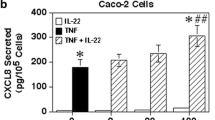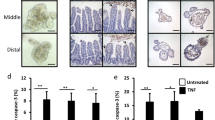Abstract
Clostridium difficile toxin A causes acute colitis associated with inflammatory cell infiltration and increased production of proinflammatory mediators. Although CX3CL1 (fractalkine) plays a role in chemoattracting monocytes/macrophages, NK cells, and T cells, little information is available on the regulated expression of CX3CL1 in response to toxin A stimulation. In this study, we investigated the role of C. difficile toxin A on CX3CL1 induction in intestinal epithelial cells. Stimulation of murine intestinal epithelial cells with toxin A resulted in the upregulation of CX3CL1. Expression of CX3CL1 was dependent on nuclear factor-kappaB (NF-κB) and IκB kinase (IKK) activation, while the suppression of activator protein-1 (AP-1) did not affect toxin A-induced CX3CL1 expression. Suppression of p38 mitogen-activated protein kinase (MAPK) significantly inhibited IKK-NF-κB signaling leading to CX3CL1 induction in C. difficile toxin A-stimulated cells. CX3CL1 was mainly secreted from the basolateral surfaces in toxin A-treated cells. Furthermore, inhibition of p38 activity attenuated the toxin A-induced upregulation of CX3CL1 in the mouse ileum in vivo. These results suggest that a pathway, including p38 MAPK, IKK, and NF-κB activation, is required for CX3CL1 induction in intestinal epithelial cells exposed to C. difficile toxin A and may regulate the development of intestinal inflammation induced by infection with toxigenic C. difficile.
Key message
-
C. difficile toxin A causes colitis with inflammatory cell infiltration.
-
CX3CL1 plays a role in chemoattracting immune cells.
-
MAPK-NF-κB signaling is required for CX3CL1 induction in toxin A-exposed cells.
-
CX3CL1 is mainly secreted from the basolateral surfaces.
-
CX3CL1 may contribute to the regulation of toxigenic C. difficile infection.











Similar content being viewed by others
References
Hirota SA, Iablokov V, Tulk SE, Schenck LP, Becker H, Nguyen J, Al Bashir S, Dingle TC, Laing A, Liu J et al (2012) Intrarectal instillation of Clostridium difficile toxin A triggers colonic inflammation and tissue damage: development of a novel and efficient mouse model of Clostridium difficile toxin exposure. Infect Immun 80:4474–4484
Lee JY, Park HR, Oh YK, Kim YJ, Youn J, Han JS, Kim JM (2007) Effects of transcription factor activator protein-1 on interleukin-8 expression and enteritis in response to Clostridium difficile toxin A. J Mol Med 85:1393–1404
He D, Sougioultzis S, Hagen S, Liu J, Keates S, Keates AC, Pothoulakis C, Lamont JT (2002) Clostridium difficile toxin A triggers human colonocyte IL-8 release via mitochondrial oxygen radical generation. Gastroenterology 122:1048–1057
Kim JM, Kim JS, Jun HC, Oh YK, Song IS, Kim CY (2002) Differential expression and polarized secretion of CXC and CC chemokines by human intestinal epithelial cancer cell lines in response to Clostridium difficile toxin A. Microbiol Immunol 46:333–342
Kim JM, Lee JY, Yoon YM, Oh YK, Youn J, Kim YJ (2006) NF-kappa B activation pathway is essential for the chemokine expression in intestinal epithelial cells stimulated with Clostridium difficile toxin A. Scand J Immunol 63:453–460
Fong AM, Robinson LA, Steeber DA, Tedder TF, Yoshie O, Imai T, Patel DD (1998) Fractalkine and CX3CR1 mediate a novel mechanism of leukocyte capture, firm adhesion, and activation under physiologic flow. J Exp Med 188:1413–1419
Tole S, Durkan AM, Huang YW, Liu GY, Leung A, Jones LL, Taylor JA, Robinson LA (2010) Thromboxane prostanoid receptor stimulation induces shedding of the transmembrane chemokine CX3CL1 yet enhances CX3CL1-dependent leukocyte adhesion. Am J Physiol Cell Physiol 298:C1469–C1480
Kostadinova FI, Baba T, Ishida Y, Kondo T, Popivanova BK, Mukaida N (2010) Crucial involvement of the CX3CR1-CX3CL1 axis in dextran sulfate sodium-mediated acute colitis in mice. J Leukoc Biol 88:133–143
Dragomir E, Manduteanu I, Calin M, Gan AM, Stan D, Koenen RR, Weber C, Simionescu M (2008) High glucose conditions induce upregulation of fractalkine and monocyte chemotactic protein-1 in human smooth muscle cells. Thromb Haemost 100:1155–1165
Inui M, Ishida Y, Kimura A, Kuninaka Y, Mukaida N, Kondo T (2011) Protective roles of CX3CR1-mediated signals in toxin A-induced enteritis through the induction of heme oxygenase-1 expression. J Immunol 186:423–431
Matsumiya T, Ota K, Imaizumi T, Yoshida H, Kimura H, Satoh K (2010) Characterization of synergistic induction of CX3CL1/fractalkine by TNF-alpha and IFN-gamma in vascular endothelial cells: an essential role for TNF-alpha in post-transcriptional regulation of CX3CL1. J Immunol 184:4205–4214
Zhang H, Guo C, Wu D, Zhang A, Gu T, Wang L, Wang C (2012) Hydrogen sulfide inhibits the development of atherosclerosis with suppressing CX3CR1 and CX3CL1 expression. PLoS One 7:e41147
Lee JY, Kim H, Cha MY, Park HG, Kim YJ, Kim IY, Kim JM (2009) Clostridium difficile toxin A promotes dendritic cell maturation and chemokine CXCL2 expression through p38, IKK, and the NF-kappaB signaling pathway. J Mol Med 87:169–180
Choi YJ, Im E, Chung HK, Pothoulakis C, Rhee SH (2010) TRIF mediates Toll-like receptor 5-induced signaling in intestinal epithelial cells. J Biol Chem 285:37570–83757
Park H, Kim NI, Kim JM, Kim JS, Oh YK, Kim YJ, Kim N, Jung HC, Song IS (2006) Expression of eotaxin in gastric epithelial cells stimulated with Helicobacter pylori vacuolating cytotoxin. J Bacteriol Virol 36:11–20
Yoo do Y, Ko SH, Jung J, Kim YJ, Kim JS, Kim JM (2013) Bacteroides fragilis enterotoxin upregulates lipocalin-2 expression in intestinal epithelial cells. Lab Invest 93:384–396
Yoon YM, Lee JY, Yoo D, Sim YS, Kim YJ, Oh YK, Kang JS, Kim S, Kim JS, Kim JM (2010) Bacteroides fragilis enterotoxin induces human beta-defensin-2 expression in intestinal epithelial cells via a mitogen-activated protein kinase/I kappaB kinase/NF-kappaB-dependent pathway. Infect Immun 78:2024–2033
Kim JM, Oh YK, Kim YJ, Oh HB, Cho YJ (2001) Polarized secretion of CXC chemokines by human intestinal epithelial cells in response to Bacteroides fragilis enterotoxin: NF-kappa B plays a major role in the regulation of IL-8 expression. Clin Exp Immunol 123:421–427
Kim JM, Jung HY, Lee JY, Youn J, Lee CH, Kim KH (2005) Mitogen-activated protein kinase and activator protein-1 dependent signals are essential for Bacteroides fragilis enterotoxin-induced enteritis. Eur J Immunol 35:2648–2657
Kim JM, Kim JS, Kim YJ, Oh YK, Kim IY, Chee YJ, Han JS, Jung HC (2008) Conjugated linoleic acids produced by Lactobacillus dissociates IKK-gamma and Hsp90 complex in Helicobacter pylori-infected gastric epithelial cells. Lab Invest 88:541–552
Kim JM, Kim JS, Jung HC, Oh YK, Chung HY, Lee CH, Song IS (2003) Helicobacter pylori infection activates NF-kappaB signaling pathway to induce iNOS and protect human gastric epithelial cells from apoptosis. Am J Physiol Gastrointest Liver Physiol 285:G1171–G1180
Kim JM, Kim JS, Lee JY, Sim YS, Kim YJ, Oh YK, Yoon HJ, Kang JS, Youn J, Kim N et al (2010) Dual effects of Helicobacter pylori vacuolating cytotoxin on human eosinophil apoptosis in early and late periods of stimulation. Eur J Immunol 40:1651–1662
Manzoor Z, Koh YS (2012) Mitogen-activated protein kinases in inflammation. J Bacteriol Virol 42:189–195
Yuk JM, Jo EK (2011) Toll-like receptors and innate immunity. J Bacteriol Virol 41:225–235
Roh HC, Yoo do Y, Ko SH, Kim YJ, Kim JM (2011) Bacteroides fragilis enterotoxin upregulates intercellular adhesion molecule-1 in endothelial cells via an aldose reductase-, MAPK-, and NF-kappaB-dependent pathway, leading to monocyte adhesion to endothelial cells. J Immunol 187:1931–1941
Vedantam G, Clark A, Chu M, McQuade R, Mallozzi M, Viswanathan VK (2012) Clostridium difficile infection: toxins and non-toxin virulence factors, and their contributions to disease establishment and host response. Gut Microbes 3:121–134
Chandrasekar B, Mummidi S, Perla RP, Bysani S, Dulin NO, Liu F, Melby PC (2003) Fractalkine (CX3CL1) stimulated by nuclear factor kappaB (NF-kappaB)-dependent inflammatory signals induces aortic smooth muscle cell proliferation through an autocrine pathway. Biochem J 373:547–558
Garcia GE, Xia Y, Chen S, Wang Y, Ye RD, Harrison JK, Bacon KB, Zerwes HG, Feng L (2000) NF-kappaB-dependent fractalkine induction in rat aortic endothelial cells stimulated by IL-1beta, TNF-alpha, and LPS. J Leukoc Biol 67:577–584
Zanchi C, Zoja C, Morigi M, Valsecchi F, Liu XY, Rottoli D, Locatelli M, Buelli S, Pezzotta A, Mapelli P et al (2008) Fractalkine and CX3CR1 mediate leukocyte capture by endothelium in response to Shiga toxin. J Immunol 181:1460–1469
Bobo LD, El Feghaly RE, Chen YS, Dubberke ER, Han Z, Baker AH, Li J, Burnham CA, Haslam DB (2013) MAPK-activated protein kinase 2 contributes to Clostridium difficile-associated inflammation. Infect Immun 81:713–722
Bhargava A, Clifton MS, Mhaske P, Liao M, Pothoulakis C, Leeman SE, Grady EF (2013) Local injection of dsRNA targeting calcitonin receptor-like receptor (CLR) ameliorates Clostridium difficile toxin A-induced ileitis. Proc Natl Acad Sci U S A 110:731–736
Goda S, Imai T, Yoshie O, Yoneda O, Inoue H, Nagano Y, Okazaki T, Imai H, Bloom ET, Domae N et al (2000) CX3C-chemokine. fractalkine-enhanced adhesion of THP-1 cells to endothelial cells through integrin-dependent and -independent mechanisms. J Immunol 164:4313–4320
Ishida Y, Gao JL, Murphy PM (2008) Chemokine receptor CX3CR1 mediates skin wound healing by promoting macrophage and fibroblast accumulation and function. J Immunol 180:569–579
Niess JH, Brand S, Gu X, Landsman L, Jung S, McCormick BA, Vyas JM, Boes M, Ploegh HL, Fox JG et al (2005) CX3CR1-mediated dendritic cell access to the intestinal lumen and bacterial clearance. Science 307:254–258
Ishida Y, Hayashi T, Goto T, Kimura A, Akimoto S, Mukaida N, Kondo T (2008) Essential involvement of CX3CR1-mediated signals in the bactericidal host defense during septic peritonitis. J Immunol 181:4208–4218
Acknowledgments
Su Hyuk Ko and Jong Ik Jeon contributed equally to this work. We thank Dr. Martin F. Kagnoff for providing standard RNA for mouse β-actin. This research was supported by the Basic Science Research Program through the National Research Foundation of Korea (NRF) funded by the Ministry of Education, Science and Technology (MEST) (NRF-2013R1A1A2A-10004404) and a grant from the NRF of South Korea funded by the Korean Government (MEST) (MRC Program, NRF-2008-0062287).
Conflict of interest
The authors declare no conflicts of interest.
Author information
Authors and Affiliations
Corresponding author
Additional information
Su Hyuk Ko and Jong Ik Jeon contributed equally to this work.
Rights and permissions
About this article
Cite this article
Ko, S.H., Jeon, J.I., Kim, H. et al. Mitogen-activated protein kinase/IκB kinase/NF-κB-dependent and AP-1-independent CX3CL1 expression in intestinal epithelial cells stimulated with Clostridium difficile toxin A. J Mol Med 92, 411–427 (2014). https://doi.org/10.1007/s00109-013-1117-y
Received:
Revised:
Accepted:
Published:
Issue Date:
DOI: https://doi.org/10.1007/s00109-013-1117-y




